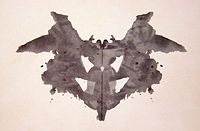
Photo from wikipedia
Abstract Background Individuals with serious mental illness (SMI) are over-represented in the criminal justice system. One factor that impacts likelihood of incarceration is criminal thinking, and the Criminal Sentiments Scale… Click to show full abstract
Abstract Background Individuals with serious mental illness (SMI) are over-represented in the criminal justice system. One factor that impacts likelihood of incarceration is criminal thinking, and the Criminal Sentiments Scale – Modified (CSS-M) has been shown to predict recidivism. However, no one has examined the CSS-M in outpatients with schizophrenia and other psychotic disorders, and little is known about what predicts high CSS-M scores. Methods The data for the current investigation comes from a larger sample of individuals with SMI receiving services from outpatient mental health clinics who were enrolled in a randomized-controlled trial. The CSS-M was verbally administered to everyone during a baseline assessment. The 264 individuals in the sample all have a diagnosis of schizophrenia or another psychotic disorder, and all had been arrested in the last five years. We first explored the impact of demographic factors and adverse childhood experiences (ACE) on CSS-M scores. For the 258 participants with complete data for all five sub-scales (attitudes towards law, attitudes towards courts, attitudes towards police, tolerance for law violations, and identification with criminal others), we conducted a hierarchical analysis using Ward’s method to explore and define the number of clusters. We determined the number of clusters using the Elbow method. We then repeated the cluster analysis using a non-hierarchical method with the K-means technique and fixing the number of clusters to three. Results The current sample exhibited considerably higher CSS-M scores than those previously published (mean = 32.0±14.4). The total CSS-M score demonstrated high reliability (alpha = 0.898), and four of the sub-scales exhibited moderate to high reliability (α,Law = 0.741; α,Courts = 0.808; α,Police = 0.762; α,TLV = 0.696). When controlling for age, race, gender, and ACE score, the multiple linear regression model accounted for 8.6% of the variability in total CSS-M score (p < 0.001), though only ACE score and age were significant predictors (β = 0.218, p = 0.001; β = -0.167, p = 0.008, respectively). The cluster analysis produced three clusters. Given that the ICO sub-scale had the lowest Cronbach’s alpha (α = 0.328), we repeated the cluster analysis process with the four other sub-scales, which confirmed the three clusters. An ANOVA with the four sub-scales and total CSS-M score showed that the three clusters could be defined as those with low, medium, and high scores on the scales. Confirming the results from the MLR, an ANOVA of the three clusters with ACE scores (F= 4.49, p = 0.012) and age (F = 3.77, p = 0.024) were both significant. Discussion The average total CSS-M score is considerably higher than previous investigations. Both high ACE scores and younger age significantly predicted higher CSS-M scores. Because CSS-M scores have been shown to predict recidivism, it is critical to further understand the foundation of these negative attitudes towards the criminal justice system to prevent the continued over-representation of people with serious mental illness in the criminal justice system.
Journal Title: Schizophrenia Bulletin
Year Published: 2020
Link to full text (if available)
Share on Social Media: Sign Up to like & get
recommendations!